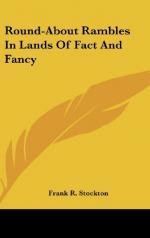There are other kinds of blossoms than apple-blossoms, or those of any tree whatever. There are little flowers which bloom as well or better in winter than in summer, and which are not, in fact, flowers at all.
These are ice-blossoms.
Perhaps you have never seen any of them, and I think it is very likely, for they can only be formed and perceived by the means of suitable instruments. And so here is a picture of some ice-blossoms.
[Illustration]
These curious formations, some of which appear like stars, others like very simple blossoms, while others are very complex; and some of which take the form of fern-leaves, are caused to appear in the centre of a block of ice by means of concentrated rays of lights which are directed through the ice by means of mirrors and lenses. Sometimes they are observed by means of a magnifying-glass, and in other experiments their images are thrown upon a white screen.
[Illustration]
We may consider these ice-flowers as very beautiful and very wonderful, but they are not a whit more so than our little blossoms of the apple-orchard.
The latter are more common, and have to produce apples, while the ice-flowers are uncommon, and of no possible use.
That is the difference between them.
ABOUT GLASS.
Glass is so common and so cheap that we never think of being grateful for it. But if we had lived a few centuries ago, when the richest people had only wooden shutters to their windows, which, of course, had to be closed whenever it was cold or stormy, making the house as dark as night, and had then been placed in a house lighted by glass windows, we would scarcely have found words to express our thankfulness. It would have been like taking a man out of a dreary prison and setting him in the bright world of God’s blessed sunshine. After a time men made small windows of stones that were partly transparent; and then they used skins prepared something like parchment, and finally they used sashes similar to ours, but in them they put oiled paper. And when at last glass came into use, it was so costly that very few were able to buy it, and they had it taken out of the windows and stored carefully away when they went on a journey, as people now store away pictures and silver-plate.
Now, when a boy wants a clear, white glass vial for any purpose, he can buy it for five cents; and for a few pennies a little girl can buy a large box of colored beads that will make her a necklace to go several times around her neck, and bracelets besides. These her elder sister regards with contempt; but there was a time when queens were proud to wear such. The oldest article of glass manufacture in existence is a bead. It has an inscription on it, but the writing, instead of being in letters, is in tiny little pictures.




